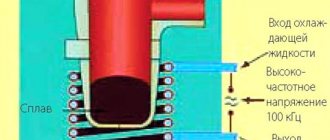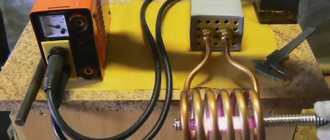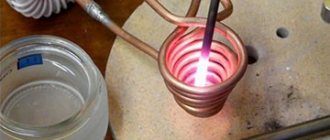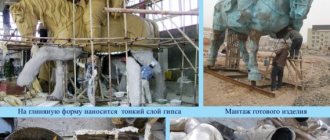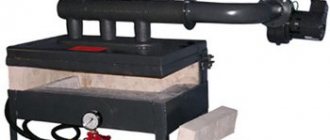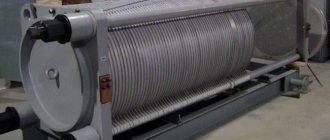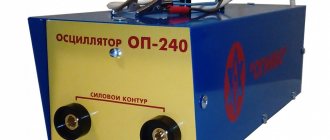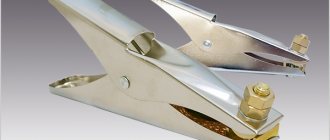Principle of operation
Such a furnace device is an electrical transformer with a secondary short-circuited winding. The operating principle of an induction furnace is as follows:
- using a generator, an alternating current is created in the inductor;
- an inductor with a capacitor creates an oscillatory circuit, it is tuned to the operating frequency;
- in the case of using a self-oscillating generator, the capacitor is excluded from the device circuit and in this case the inductor’s own reserve capacitance is used;
- the magnetic field created by the inductor can exist in free space or be closed using an individual ferromagnetic core;
- the magnetic field acts on the metal workpiece or charge located in the inductor and forms a magnetic flux;
- according to Maxwell's equations, it induces a secondary current in the workpiece;
- with a solid and massive magnetic flux, the created current is closed in the workpiece and a Foucault current or eddy current is created;
- after the formation of such a current, the Joule-Lenz law comes into effect, and the energy obtained using an inductor and a magnetic field heats the metal workpiece or charge.
Despite multi-stage operation, the induction furnace device can provide up to 100% efficiency in vacuum or air. If the medium has magnetic permeability, then this indicator will increase; in the case of a medium made of a non-ideal dielectric, it will fall.
Device
The furnace in question is a kind of transformer, but it does not have a secondary winding; it is replaced by a metal sample placed in the inductor. It will conduct current, but the dielectrics do not heat up in this process, they remain cold.
The design of induction crucible furnaces includes an inductor, which consists of several turns of a copper tube, coiled in the form of a coil, with coolant constantly moving inside it. The inductor also contains a crucible, which can be made of graphite, steel and other materials.
In addition to the inductor, the furnace has a magnetic core and a hearth stone, all of which are enclosed in the furnace body. It includes:
- induction unit casing;
- bathroom casing;
- frame.
In high-power furnace models, the bath casing is usually made quite rigid, so there is no frame in such a device. The housing fastening must withstand strong loads when the entire oven is tilted. The frame is most often made of shaped beams made of steel.
A crucible induction furnace for melting metal is installed on a foundation into which supports are mounted; the axles of the tilting mechanism of the device rest on their bearings.
The bath casing is made of metal sheets, onto which stiffeners are welded for strength.
The induction unit casing is used as a connecting link between the furnace transformer and the hearth stone. To reduce current losses, it is made of two halves, between which there is an insulating gasket.
The halves are connected using bolts, washers and bushings. Such a casing is made cast or welded; when choosing a material for it, preference is given to non-magnetic alloys. The two-chamber induction steelmaking furnace comes with a common casing for both the bath and the induction unit.
In small ovens that do not have water cooling, there is a ventilation unit that helps remove excess heat from the unit. Even if you install a water-cooled inductor, you need to ventilate the opening near the hearth stone so that it does not overheat.
Modern furnace installations not only have a water-cooled inductor, but also provide water cooling of the casings. Fans powered by a drive motor can be installed on the furnace frame. If such a device has a significant mass, the ventilation device is installed near the stove. If an induction furnace for steel production comes with a removable version of induction units, then each of them is provided with its own fan.
Separately, it is worth noting the tilt mechanism, which for small ovens comes with a manual drive, and for large ones it is equipped with a hydraulic drive located at the drain spout. Whatever the tilt mechanism is installed, it must ensure that the entire contents of the bathroom are completely drained.
Power calculation
Since the induction method of steel melting is less expensive than similar methods based on the use of fuel oil, coal and other energy sources, the calculation of an induction furnace begins with calculating the power of the unit.
The power of an induction furnace is divided into active and useful, each of them has its own formula.
As initial data you need to know:
- the capacity of the furnace, in the case considered for example, it is 8 tons;
- unit power (its maximum value is taken) – 1300 kW;
- current frequency – 50 Hz;
- The productivity of the furnace plant is 6 tons per hour.
It is also necessary to take into account the metal or alloy being melted: according to the condition, it is zinc. This is an important point, the heat balance of cast iron melting in an induction furnace, as well as other alloys, is different.
Useful power transferred to liquid metal:
- Рpol = Wtheor×t×P,
- Wtheor – specific energy consumption, it is theoretical, and shows the overheating of the metal by 10C;
- P – productivity of the furnace installation, t/h;
- t – overheating temperature of the alloy or metal billet in the bath furnace, 0C
- Rpol = 0.298×800×5.5 = 1430.4 kW.
Active power:
- P = Ppol/Yuterm,
- Rpol – taken from the previous formula, kW;
- Yuterm is the efficiency of a foundry furnace, its limits are from 0.7 to 0.85, with an average of 0.76.
- P = 1311.2/0.76 = 1892.1 kW, the value is rounded to 1900 kW.
At the final stage, the inductor power is calculated:
- Rind = P/N,
- P – active power of the furnace installation, kW;
- N is the number of inductors provided on the furnace.
- Rind =1900/2= 950 kW.
The power consumption of an induction furnace when melting steel depends on its performance and the type of inductor.
Installation Features
Each specific induction furnace is equipped, among other things, with detailed instructions containing detailed technical data and operating rules.
The most important of them include:
- — strict monitoring of temperature conditions during operation, since even a minor violation will destroy the lining;
- — the temperature of the water supplied to the inductor must be high enough for the given room, otherwise a large amount of condensation may form on the tubes of the water vapor inductor, and there will be a danger of electrical breakdown between the turns of the inductor;
- — overheating of water at the outlet of the inductor is also unacceptable, in order to avoid the formation of scale on the walls of the pipes, which disrupts heat exchange;
- — placement of equipment in enclosed spaces located no higher than 1 km above sea level, with a positive temperature, normal air humidity and without aggressive impurities.
The operation of induction furnaces must be monitored by qualified specialists, preventive inspections must be carried out and deficiencies must be corrected in a timely manner.
Species and subspecies
Induction furnaces are divided into two main types:
- Duct. In it, the secondary turn is a circular short-circuited channel into which the metal is placed. A generator or alternating current of industrial frequency is used as an energy source for the smelting process. The high efficiency of such furnaces is due to the transmission of a high-frequency field through a ferrite or steel core. Steel melting in induction furnaces of this type is characterized by the continuous supply of metal blanks and the production of molten metal. The only drawback of the channel unit is the difficulty of starting its operation, since it is first necessary to fill the channel with the melt.
- Crucible. In such furnaces, the energy source is a generator that can operate in the range from several tens to hundreds of kHz. Metal blanks in this type of furnace are placed in its heat-resistant crucible, which is located in the inductor winding. As soon as the melt reaches the desired temperature, the crucible is emptied and filled with the next batch of raw materials. Such a furnace device is characterized by a high rate of heating of the metal, since heat loss in the crucible is very small.
In addition to this division, induction furnaces are compressor, vacuum, open and gas-filled.
What are the differences from other plates?
Induction cookers compare favorably with other types of stoves (gas and electric).
A number of points are worth highlighting:
The efficiency of induction furnaces reaches 90%. For comparison, in gas stoves this figure is only 30-60%, and in electric stoves - no more than 70%; High heating rate (devices with heating elements or gas burners cannot boast of this feature); Efficiency. After removing the dishes, you do not need to turn off the work area manually - this happens automatically. In electric or gas stoves, the burner continues to work, which leads to excessive consumption of gas and electricity
In the summer, this is especially important, because there is additional heating of the air, which complicates the process of air conditioning (cooling) the room; Precise temperature control. On stoves with heating elements or gas-fired, temperature control occurs “by eye”
In the case of induction cookers, you can maintain the same setting throughout the entire cooking time;
Safety. If a person accidentally mixes up the cookware and places a product with a non-magnetic bottom, the burner will not work. To activate the burner, the cookware must cover its area as much as possible, 50% or more; Many additional functions that classic gas or electric stoves cannot boast of.
DIY induction furnaces
Among the available common methods for creating such units, you can find a step-by-step guide on how to make an induction furnace from a welding inverter, with a nichrome spiral or graphite brushes; we will give their features.
High frequency generator unit
It is performed taking into account the design power of the unit, eddy losses and hysteresis leaks. The structure will be powered from a regular 220 V network, but using a rectifier. This type of furnace can be equipped with graphite brushes or a nichrome spiral.
To create a furnace you will need:
- two UF4007 diodes;
- film capacitors;
- field-effect transistors, two pieces;
- 470 Ohm resistor;
- two throttle rings, they can be removed from an old computer system technician;
- copper wire Ø section 2 mm.
The tools used are a soldering iron and pliers.
Here is a diagram for an induction furnace:
Induction portable melting furnaces of this type are created in the following sequence:
- Transistors are located on radiators. Due to the fact that during the process of metal melting the device circuit heats up quickly, the radiator for it must be selected with large parameters. It is permissible to install several transistors on one generator, but in this case they need to be isolated from the metal using gaskets made of plastic and rubber.
- Two chokes are manufactured. For them, two rings previously removed from the computer are taken, copper wire is wound around them, the number of turns is limited from 7 to 15.
- The capacitors are combined into a battery to produce a capacitance of 4.7 μF at the output; they are connected in parallel.
- A copper wire is wrapped around the inductor; its diameter should be 2 mm. The inner diameter of the winding must match the size of the crucible used for the furnace. A total of 7-8 turns are made and long ends are left so that they can be connected to the circuit.
- A 12 V battery is connected to the assembled circuit as a source; it lasts for about 40 minutes of oven operation.
If necessary, the housing is made from a material with high heat resistance. If an induction melting furnace is made from a welding inverter, then a protective housing must be present, but it must be grounded.
Graphite brush design
Such a furnace is used for smelting any metal and alloys.
To create a device you need to prepare:
- graphite brushes;
- powdered granite;
- transformer;
- fireclay brick;
- steel wire;
- thin aluminum.
The technology for assembling the structure is as follows:
- The base is made in the form of a box, which is made of fireclay bricks, it is placed on a fire-resistant tile.
- A sheet of asbestos cardboard is placed on top of the box; if it needs to be given a certain shape, its surface must be moistened with water. To make the structure rigid, you need to wrap it with wire. The dimensions of the box depend on the power of the transformer. It is best to use it from a welding machine. If it is of high power, then it should be rewound.
- To prevent the transformer from overheating, it is wrapped in thin aluminum.
- There is a clay substrate at the bottom of the brick box to prevent the molten metal from spreading.
- Graphite brushes are installed.
Device with nichrome spiral
Such a device is used for smelting large volumes of metal.
The following materials are used as consumables for setting up a homemade stove:
- nichrome;
- asbestos thread;
- piece of ceramic pipe.
After connecting all the components of the furnace according to the diagram, its operation is as follows: after applying electric current to the nichrome spiral, it transfers heat to the metal and melts it.
The creation of such a furnace is carried out in the following sequence:
- Winding a spiral, a wire with a diameter of 0.3 mm is used for it, the length of the workpiece should be about 11 meters.
- The wire is wound around a long tube, its diameter is 5 mm.
- A piece of ceramic pipe acts as a crucible; it is cut to the required size, about 15 cm. An asbestos thread is inserted into one end so that the molten metal does not spread.
- Laying a spiral around a pipe. An asbestos thread is placed between its turns; it will limit the access of oxygen and thereby prevent a short circuit in the furnace.
- In this form, the coil is placed in a high-power lamp, it contains a cartridge of the required diameter, which is most often made of ceramics.
This design is characterized by high performance; it cools down for a long time and heats up quickly. But it is necessary to take into account that if the spiral is poorly insulated, it will quickly burn out.
Prices for ready-made induction furnaces
Homemade furnace designs will cost much less than purchased ones, but they cannot be created in large volumes, so you cannot do without ready-made options for mass production of the melt.
Prices for induction furnaces for metal melting depend on their capacity and configuration.
| Model | Characteristics and Features | Price, rubles |
| INDUTHERM MU-200 | The furnace supports 16 temperature programs, the maximum heating temperature is 1400 0C, the mode is controlled with an S-type thermocouple. The unit produces a power of 3.5 kW. | 820 thousand |
| INDUTHERM MU-900 | The furnace operates from a power supply of 380 V, temperature control occurs using an S-type thermocouple and can reach up to 1500 0C. Power – 15 kW. | 1.7 million |
| UPI-60-2 | This mini induction melting furnace can be used for melting non-ferrous and precious metals. The workpieces are loaded into a graphite crucible, and they are heated according to the transformer principle. | 125 thousand |
| IST-1/0.8 M5 | The furnace inductor is a basket in which a magnetic circuit is built together with a coil. Unit 1 ton. | 1.7 million |
| UI-25P | The furnace device is designed for a load of 20 kg, it is equipped with a geared inclination of the melting unit. The stove comes with a block of capacitor batteries. Installation power – 25 kW. Maximum heating t is 1600 0C. | 470 thousand |
| UI-0.50T-400 | The unit is designed for a load of 500 kg, the highest power of the installation is 525 kW, the voltage for it must be at least 380V, the maximum operating temperature is 1850 0C. | 900 thousand |
| ST 10 | The oven of the Italian company is equipped with a digital thermostat; SMD technology is built into the control panel, which is fast. The universal unit can work with different capacities from 1 to 3 kg, for this it does not need to be readjusted. It is intended for precious metals, its maximum temperature is 1250 0C. | 1 million |
| ST 12 | Static induction oven with digital thermostat. It can be supplemented with a vacuum casting chamber, which makes it possible to carry out casting right next to the installation. Control occurs using the touch panel. Maximum temperature – 1250 0С. | 1050 thousand |
| IChT-10TN | The furnace is designed for a load of 10 tons, it is a rather voluminous unit, for its installation you need to allocate a closed workshop room. | 8.9 million |
Homemade water heating boiler
The basis of such a water heater is a power transformer with a power of up to 1.5 kW, the primary winding of which is designed for a voltage of 220 V. A transformer from a tube color TV is ideal. The secondary winding should be removed, and the number of turns of the primary should be increased.
Craftsmen advise and warn: using such a homemade device is unsafe, so the transformer should be grounded, and the device itself should be connected through a high-speed RCD.
